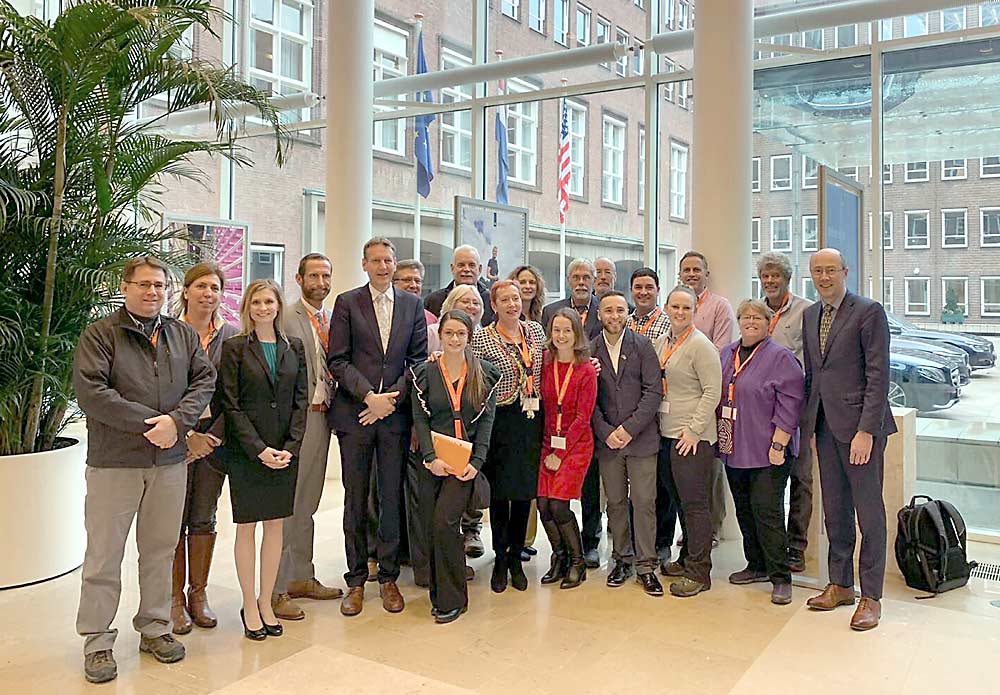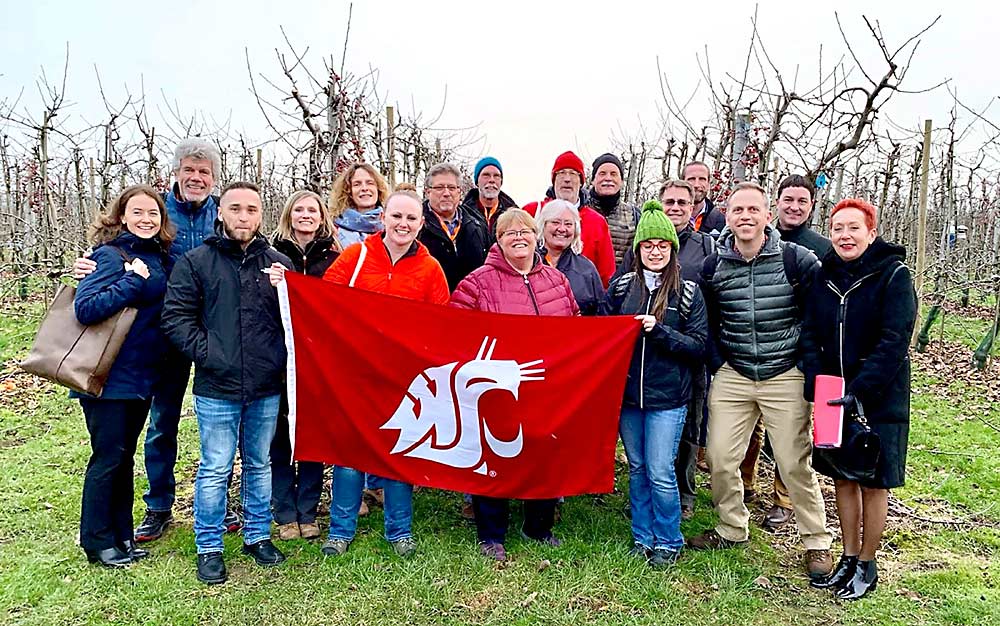
A delegation led by the Washington Tree Fruit Research Commission visits the Ministry of Agriculture, Nature and Food Quality in The Hague, Netherlands, in February. The group visited several research centers and areas of technological development of interest to the tree fruit industry. While in The Hague, the group met with the minister for agriculture to discuss how to better align common goals and find opportunities to collaborate in emerging ag technologies such as robotics, food safety and automation. The delegation also included members from Washington State University, Oregon State University and the Washington State Department of Agriculture. (Courtesy Washington Tree Fruit Research Commission)
Earlier this year, representatives of the Washington Tree Fruit Research Commission, Washington State University, Oregon State University and the Washington State Department of Agriculture spent 10 days touring centers of research and innovation in Europe to find new tools, new ideas and cultivate new relationships.
They also found some surprises.
“I went to Europe with the concept that they would be like 10 years ahead of us with technology, but that was not the case,” said Teah Smith, who chairs the commission’s apple crop protection committee and works for Zirkle Fruit Co. “I think we’re neck-and-neck with them.”
But she’s already reached out to several companies whose technology intrigued her, including scouting and imaging programs, to discuss future collaborations.
Many members of the tour group shared similar sentiments in a March presentation about what they learned from their time in the Netherlands and Germany.
“In 2010, when we were in Italy, I did feel like they were 10 years ahead in some ways; now I feel like we’ve closed the gap, and that’s highly encouraging,” said Tom Butler, fieldman for Washington Fruit and Produce Co.
The whirlwind tour included Wageningen University in the Netherlands, one of the leading agricultural research centers in the world; commercial producers of beneficial insects and low-oxygen storage technology; automated orchid growers; the largest wholesale fresh flower market it the world; and a new organic apple packing line using hot water sanitation.
Other highlights: a chance to meet a dragonfly-inspired drone and a visit with a grower who bought an automation kit for his tractor so he can drink coffee with his wife in the mornings.
The emphasis on sustainable food production was apparent throughout the tour, from reducing pesticide use in the field to lower energy use in storage.
“One of the things that intrigued me was their focus on reusable, repurposable and recyclable packaging,” said Jeff Cleveringa of Oneonta Starr Ranch Growers. “Retailers here are also interested in that.”

A delegation led by the Washington Tree Fruit Research Commission visits the Wageningen Research Center, Proeftuin Randwijk orchard on February 6, 2019, in Wageningen, Netherlands. (Courtesy Washington Tree Fruit Research Commission)
He also shared a video of the autonomous tractor they watched navigate orchard rows. Similar technology to add an automation system to existing tractors is available in the U.S. as well, Cleveringa said. The downside to the technology is that the grower is legally required to monitor it — although what that means exactly remains unclear — and can’t allow it to drive on the road to other blocks nearby.
Other promising robotic solutions for weed control: an automated weeder that uses cameras and machine learning to understand crop patterns and weed around lettuce while moving several miles an hour through the field, and a precision sprayer that senses chlorophyll concentrations and adjusts its nozzles accordingly.
Butler said he was intrigued by an LED lab where researchers were exploring use of the lights to detect pathogens, which could allow food safety programs to ensure cleaning programs are working, and by a company developing tools for monitoring ultra-low oxygen storage.
“I was impressed with the presentations at Potsdam,” he said, referring to the German Institute of Agricultural Technology, where the group listened to presentations on proximal sensing, new approaches to assess apple maturity and postharvest research. “It’s not something you can bring home and put on the table and say, ‘There it is!’ It’s more about concepts and ideas of where you can go with this and foster it.”
Cultural differences stood out on the tour, such as the education system and the collaborative, problem-solving approach to issues that might be addressed with regulation in the U.S. University researchers appeared to collaborate more closely with companies to commercialize technology than is the norm at American institutions.
But on the other hand, the researchers didn’t seem to work closely with growers, as many expected. Hans van Someren Gréve, retired Stemilt executive and Dutch-native, explained that the apparent disconnect stems from the Wageningen researchers’ aim to support growers internationally — applying technology on a scale that doesn’t exist in their homeland.
“The average Dutch grower has 40 acres,” he said. “These ideas have commercial applications where we grow, on the scale that we grow.”
The Netherlands portion of the tour was organized by the Dutch government, and the commission organized the German portion.
The Dutch plan to make a reciprocal visit to Washington in July, commission Executive Director Ines Hanrahan said. She hopes to get a few of the most exciting, relevant researchers to attend the Washington State Tree Fruit Association’s annual meeting to share their work with the wider Washington industry as well.
“I think we saw all the right people,” van Someren Gréve said. “My big hope is some lasting relationships come out of this.” •
—by Kate Prengaman






[…] Click here to view original web page at goodfruit.com […]